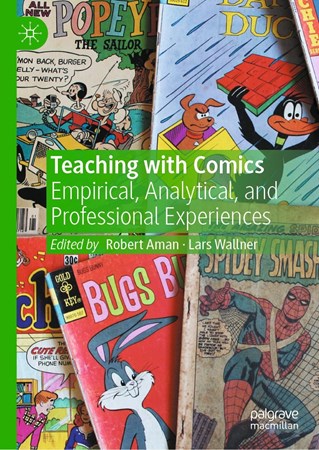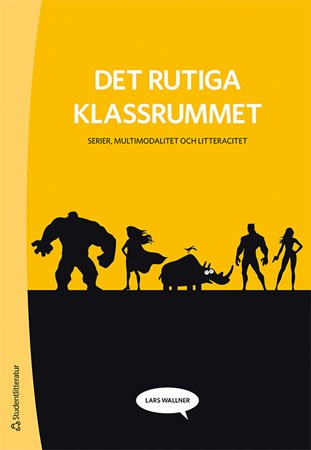This project aims to contribute new knowledge on the use of comic books and graphic novels (henceforth: comics) as a resource to engage secondary school students (ages 13-18) in norm-critical discussions. We investigate how the visual and linguistic content of the comics medium can encourage and enable space for norm-critical discussions on gender, ethnicity, ability, sexuality and social class (e.g., hooks, 1994; Kalonaityté, 2014; Kumashiro, 2001). As popular cultural materials, comics are on the forefront when it comes to issues regarding norms. The development of comics in the past decade has sparked debate among both fans and creators about representation in comics, and how the medium has a responsibility to its readers (see, for example, Costello, 2009; Fawaz, 2016; Moore, 2003). For example, in the Swedish comics industry, feminist comics have proliferated over the past decades. Creators such as Liv Strömquist, Nina Hemingsson and Sara Granér, among others, have played a key role in cultural debate on issues of feminism. Recently published works also include, among others, experiences of characters who identify as transgender (Warnqvist, 2017), precariousness on the labour market in a class-based Swedish society (Nilsson, 2018), and protagonists that battle institutionalized racism (Aman, 2020).
Furthermore, comics have already proven useful as materials in the classroom. Several recent studies on comics as school materials show their versatility and usefulness in terms of, for instance, enhancing literacy (Wallner, 2017a), foreign language learning (Graham, 2011), the teaching of sciences (Cheesman, 2006), and engaging in gender discussions. Use of visual literature enables teachers to engage students of different levels of language skill and opens for engagement with social issues textually and visually (Wallner, 2017a). Thus, comics are a versatile medium, motivating youths to read, learn and engage in social issues.
Although comics are not included in the Swedish curricula, Skolverket has recently produced classroom materials around comics (Johansson, 2017), recognising the usability and popularity of the medium. In what is often described as school’s double objectives of passing on knowledge and values, critiquing norms can be regarded as part of fulfilling democratic values (Skolverket, 2019, 2020). Kumashiro (2001, p. 8) asserts that “education involves … learning something that disrupts one’s common-sense view of the world,” while adding that it is necessary that pupils are given the opportunity to develop a norm-critical gaze to identify and uncover power relations and norms to be able to challenge and change them. Åkesson (2016, p. 10) argues that one way to work with norm-critical perspectives in education could be to “offer all students entrance to a cultural range that strengthens them and gives them insight and joy regardless of background, functionality, sexuality, class, skin colour, gender and experience”. Being a rarity in Swedish classrooms (Wallner, 2017a), comics are in themselves a disruption of normal literacy practices and, therefore, an apt medium for norm-critical school practices. Furthermore, Skolverket (2017) underlines that many students are familiar with comics either from childhood or adolescence, and these materials could be a ‘cultural range’ where they feel comfortable discussing these issues.
Research focus
To fulfil the aim of the current project, the following research questions will be answered:
- In what ways can students and teachers utilize the visual and linguistic content of the comics medium for norm-critical discussions?
- In what ways do students challenge vis-à-vis reinforce social norms in interactions with teachers and peers around comics?
- What pedagogical implications can be identified in working with comics as a vehicle to teach norm-critical perspectives
Project description
The current project proposes to study the use of comics in educational settings as materials for engaging with norm-critical discussions to challenge various forms of oppression. This includes the reading of comics as a way for students to discuss and problematize their views of social class, gender, sexuality, ethnicity, and ability from different perspectives (Björkman & Broseth, 2019) and the intersection of such categories (De los Reyes & Mulinari, 2005). The project also takes advantage of comics’ capacity to open up space visually and textually for representations of social identities beyond the normative order (Fawaz, 2016); that is, moving away from dominant norms that privileges heterosexuality, masculinity, whiteness etc. (hooks, 1994; Kumashiro, 2001). In short, comics offer cultural tools to critique the social order while being capable of imagining alternative visions to such norms (Fawaz, 2016).
Comic Materials
The comics used in the classrooms are to be selected in dialogue with the teachers involved, where a suggested reading list could include:
- Wage Slaves (Daria Bogdanska), for its autobiographical depiction of exclusion due to ethnicity and social class in Sweden,
- Ms Marvel (G. Willow Wilson, et al), where the main character is a Pakistani American Muslim teenager,
- She-Hulk (Dan Slott, et al), which follows a powerful female main character who fights for social justice,
- Nattbarn and Iggy 4-ever (Hanna Gustavsson), which raise questions around social class and gender identity,
- Persepolis (Marjane Satrapi), the autobiographical story of Satrapi’s youth in Iran, relationship to God, and struggles as a female Iranian artist in Europe,
- Spider-Man (Brian Michael Bendis, et al), in which young Miles Morales, an African American teenager, takes on the famous Spider-Man suit to fight crime,
- Nya Norrland (Mats Jonsson), depicting relations between city and countryside, social class, and the individual’s relationship to their hometown, and
- Kunskapens frukt (Liv Strömquist); which deals with feminist struggles, menstruation, and other taboo issues.
- These are suggestions that could be good starting points for a discussion with teachers about what they would like to do in their classrooms.
Field and Data collection
To study how participants engage in constructing social order and intersubjectivity in a situated social setting (Potter, 2010, Ten Have, 2004; Wiggins, 2017), access to classrooms, students and teachers is required. Methodologically, experimental or intervention studies have been the most common methods of investigating the use of comics in education (Wallner & Eriksson Barajas, 2020a), although some studies have been performed through ethnographic observations (for example, Hammond, 2009; Helsby, 1999). This gives the benefit of interaction that can be considered naturalistic, and relatively untampered by the researchers (Potter, 2010), meanwhile allowing teachers and students to do their work unhindered, and without the study taking up any extra time. Since human interaction is often dependent on body movement, eye gaze and small gestures (Wiggins, 2017), data collection will be done through video and audio recording, to be able to study the interaction repeatedly to catch these interactional details.
Initial data collection is planned for Spring 2022.



